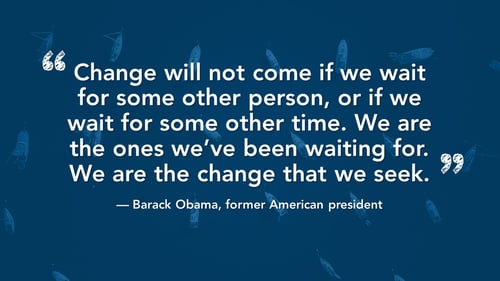Leadership is like sailing: it's easy when the conditions are right (and hopefully as great leaders, we create the right conditions … most of the time). Even the best leader, however, is going to run into a squall (keeping with the sailing analogy) and will benefit from a plan for handling these rough patches.
I read somewhere that 95% of what leaders do could be done effectively by a reasonably intelligent high school senior; you as leader earn your pay on the other 5%. And, I would argue, having those difficult performance conversations falls squarely in that other 5%.
 Having difficult conversations with an employee about his or her performance or behavior is challenging for several reasons:
Having difficult conversations with an employee about his or her performance or behavior is challenging for several reasons:
- There's a tendency for some managers to think too hard and wait too long before addressing the issue.
- There's a tendency for other managers to not think hard enough and to jump too quickly in addressing the issue.
- The conversation is — or quickly becomes — confrontational.
- We may not feel that we have all the facts.
- The facts that we have seem overly subjective or arbitrary.
- We have an unfounded hope that "it'll go away." Spoiler: it doesn't.
Know When to Have the Difficult Conversation
A difficult conversation should NOT be the first time an employee hears about the performance issue. If your employee is shocked or surprised to hear there is an issue, you have not done due diligence to address this before it reaches the difficult conversation point. Continuous feedback helps ensure there are no surprises.
Except for extreme situations — like serious policy violations — a difficult conversation should never be the first time the issue is raised with the employee. But how do you KNOW when you’ve done enough as a manager? How do you know that it’s clearly the employee’s issue to deal with?
In our leadership development programs, we introduce participants to Entelechy's Performance Management Checklist and ask participants to step through the questions to determine if they as managers have provided the support employees need to perform. (See our article on enabling performance, Be a Performance Champion; Be a Leader, for additional detail.) This checklist ensures that we as leaders 1.) have provided what employees need to perform, and 2.) need to act.
Plan the Conversation
While many employee conversations can and should be spontaneous, a difficult conversation REQUIRES preparation. Ask yourself:
- What is the purpose of this meeting? What do you want the outcome of this conversation to be? We want our focus to be on changing behavior, not on changing the employee's perspective or attitude. We can't change what someone thinks or believes; we CAN request that an employee change his or her behavior.
- What are you hoping to achieve? What would be the ideal outcome of this conversation? What’s the minimally-acceptable outcome?
- Why is addressing this issue important? Build your confidence knowing WHY it’s important to address this performance or behavior issue!
Continue the preparation by clarifying to yourself (so you can clarify to the employee):
- What specifically is the problem? You'll need to be specific in describing the behavior or performance. Make sure you're describing behaviors; for example, if you're discussing "bad attitude" then describe what that looks like: rolling of the eyes, raised voice, sharp tone, slamming doors, etc. Or, if you're describing tardiness, be ready to explain how frequently and how many minutes late.
- What is the impact of this performance or behavior? Describing the impact of the employee's behavior or performance is the most powerful tool you have! Often employees don't fully realize the negative impact — on themselves, on you, on their peers, on the customer — of their actions. Note: this is perhaps the most critical part of the preparation AND of the conversation itself. No one wakes up in the morning saying, "I'm going to be a jerk today," or "I’m going to under-perform today." However, they may not realize the full magnitude of their actions and, by better understanding the impact, the employee may more readily want to change their behavior.
- Which of these impacts carry the most weight with the employee? Select the impacts that matter most to the employee. For example, some employees don’t care about impact on the company, but are devastated to know that their behavior is negatively impacting the team.
Continue the preparation by asking yourself:
- What are some acceptable solutions (and what solutions might the employee come up with that are unacceptable)? To the greatest extent possible, we want to include the employee in coming up with a solution to the performance or behavior problem. It is important that we identify BEFORE the conversation some acceptable and unacceptable solutions so we won't get caught by surprise and perhaps agree to something that we shouldn't. Having thought ahead of time about acceptable and unacceptable solutions also ensures that we have options should the employee not be able to come up with any. Plus, it makes us more confident in our conversations.
Acceptable solutions should include:
 Specific steps: What specifically should the employee do to address the problem? Are there things YOU should be doing to support the change?
Specific steps: What specifically should the employee do to address the problem? Are there things YOU should be doing to support the change?- Timeframe: Some behaviors — like coming to work on time — begin immediately, but we may want to set an end date to our monitoring. For example, we may monitor attendance closely over the next three months.
- Consequences: Depending on the severity of the behavior/performance, we may wish to outline potential consequences if the behavior/performance doesn't improve. Consequences could be formal corrective action, ineligibility for promotion or pay increase, more oversight by you (less autonomy for the employee), less desirable projects, etc. (Contact us for a comprehensive list of possible consequences. Many managers feel powerless when it comes to consequences; we can help!)
- Follow-up date: You will want to establish a follow-up date to indicate the seriousness of this conversation AND to revisit the employee's behavior/performance. This follow-up will enable you to provide continued feedback — constructive (if behavior/performance isn’t quite there yet), OR positive (if behavior/performance has improved).
Now that you've done the preparation, you're almost ready to conduct the difficult conversation with the employee. Before you have the conversation, consider the following:
- Establish a private location. Difficult conversations should be held in private. Additionally, consider the timing; later in the day allows the employee to head home to avoid embarrassment and/or cool off and reflect on the conversation.
- Think about how you will engage the employee as an active participant in the conversation. The goal is to have the employee change his/her behavior. Invite acknowledgement of the impact: "Can you see how this might be an issue?" Ask the employee for his/her ideas and solutions. (Remember, you've already identified solutions that are acceptable and unacceptable to you, so you're ready to invite the employee to come up with their solutions.)
- Prepare to acknowledge concerns or new data. You usually will learn things in a difficult conversation that may change your course of action. Be prepared to be flexible. At the same time, the employee's performance or behavior was unacceptable enough for you to call this meeting; the employee "owns" his/her behavior and new data typically doesn't change that.
- Plan for/expect challenges. What will you do when the employee cries, becomes angry, refuses to speak to you, etc.? Having thought about your reaction ahead of time ensures that you won't be caught by surprise.
- Prepare to remain calm and poised. Difficult conversations are … well … difficult. Diffuse the emotion by remaining calm. Show empathy: "I can see how this may be upsetting." Demonstrate hope: "I know you can change this."
- Prepare to suggest a break, if necessary. Nothing says you have to push on with an unproductive conversation. You may wish to continue in 10 minutes or the next day.
- Don't avoid the conversation. And if you paused the conversation to calm down or allow the employee to calm down, don't avoid continuing the conversation.
Have the Conversation
 Preparation is truly 80% of the effort when it comes to difficult conversations.
Preparation is truly 80% of the effort when it comes to difficult conversations.
Invite the employee to the meeting. You may want to send an email or talk to the person live; do not get into the details.
If you expect antagonism or fear for your safety, invite another manager or HR business partner into the meeting.
Use your preparation notes to guide you through the difficult conversation (as illustrated on the right).
Explain the impact. Emphasize the impact. Employees may dispute the "facts" but they can't argue with your perception of the impact.
Invite collaboration. Use an inviting tone. Lean forward. Display empathy. The goal is to change behavior and you will be unsuccessful if the employee doesn't view you as an ally/supporter and this conversation as the first step. As you're collaborating to an acceptable solution (the middle part of the model), be prepared to:
- Support and Build: If the employee comes up with appropriate solutions, you will want to support and build.
- Redirect: If the employee comes up with inappropriate solutions — perhaps shirking responsibility, blaming others, making unreasonable requests, etc. — you should redirect the employee's focus on what is HIS/HER responsibility, REALISTIC solutions, etc. If you are acting on second-hand information and the employee asks, "Who told you that?" reply, "I obviously will not violate confidentiality, but I believe the information to be credible and want to work with you to address the issue."
- Tell: If the employee can't or won't come up with acceptable solutions, you should tell the employee what you consider an acceptable solution. For example, if the employee does not agree to the impact, the leader may want to simply state the impact and skip the step of "Invite Input and Collaboration." The leader should move to "Tell" and provide: Specific Steps, Consequences, Timeframe, and a Follow-up Date.
Throughout the conversation, remember that you are responsible for the performance of your entire team. If you let the bad performance or behavior of any one person go unaddressed because you are uncomfortable dealing with it, you are being unfair to everyone else on the team. As a result, you would not be fulfilling your job responsibilities as a manager. It is your responsibility to address any individual issues that are affecting the team’s performance or morale.
It's why you get paid the big bucks.
Recommended Reading
A Difficult Conversation is just one of the Three Performance Conversations every leader should master. The other two are Feedback and Coaching. Learn more about each conversation and access our handy models to help guide you through each type of conversation:

